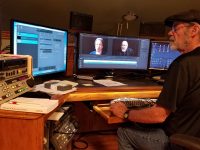Ok, so we are deep into production and fundraising for the Being Mennonite in America documentary. But when not videotaping or looking for that elusive dollar, we are finally to the point where we can do some creative editing. Editing, while excruciatingly mundane, is possibly the most creative part of film making. Now is when the documentary begins to take form - a form that will change many times before it is completed. But one can begin to see the possibilities.
If editing is excitingly creative, why so mundane? A few stats help see why. Here is what we have accumulated thus far and what we have to work through.
Nearly 70 video and audio interviews.
About 700 pages of transcriptions and notes.
Something over 25,000 computer files.
Nearly 5000 video files.
Over 150 terabytes of data on hard drives.
So? What does all this mean.
Let's start with transcriptions. Each interview is transcribed (yes, by hand, mostly, with a little help from a computerized transcription service) so that we can retrieve the contents easily. When you are looking for something specific someone has said it is quicker and easier to find its location by reviewing a digital transcript than listening to hours of audio.
As to the many files, they get worked and reworked. Cameras squeeze video files to make them smaller so they fit neatly onto small data chips. But compressed files give editing software constipation. So we convert them. Each files takes from 5 to 30 minutes to convert. (From what I am told, that's quicker than most Mennonite conversion!!) After conversion each file is ingested into the editing software and assigned a series of metadata tags. Things like the original name of the file, the name of the file once inside the editing software, keywords that correspond to the keywords in the transcriptions, who owns the copyright, and a bunch of other things. Yup, all done by hand on a keyboard.
How many hard drives does all this take? So far, we have approximately 150 Terabytes (it appears that this would hold about 2/3 of the Library of Congress' text collection) on 23 hard drives connected to the computer. They live inside six high speed arrays. Half contain the original video files while the other half contain backups. Another set of drives stored on shelves contain another backup set. Still another set of backups resides in a safe deposit box so that if a disaster destroys the office, we still haven't lost the project. At times, the off-line drives even accompany us home!! The rationale being that if the office is destroyed while we are away, we still haven't lost the project. Hey, paranoia in this case, is the best insurance!
From all this and more yet to come, we cut, chop, massage and dissect little ones and zeros into a fully formed film that tells a story. I couldn't help doing a quick cut of the Menno Beans coffee shop in Hillsboro, Kansas to share with you. Click below to enjoy.
More coming later! Our next interview is with the Mennonite author of, "From Nonresistance to Justice." Then on to the Virginia Relief Sale where we'll be documenting one of the primary Mennonite rituals.



Tina Siemens
Calvin King
Bob Gerber